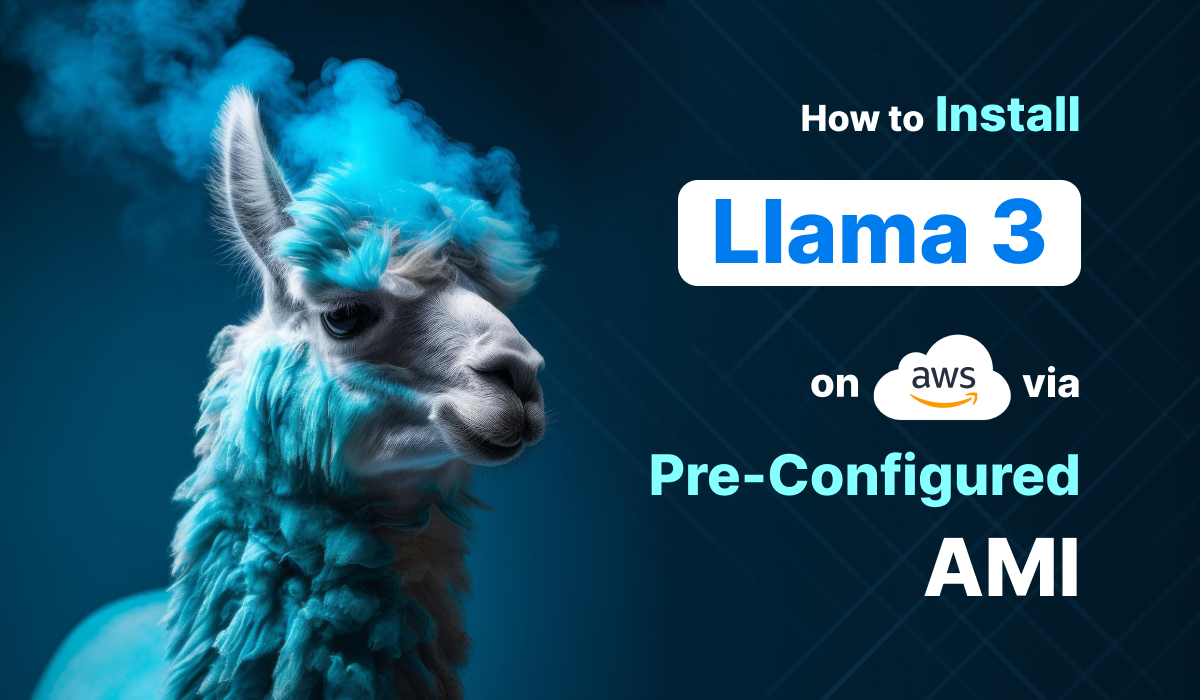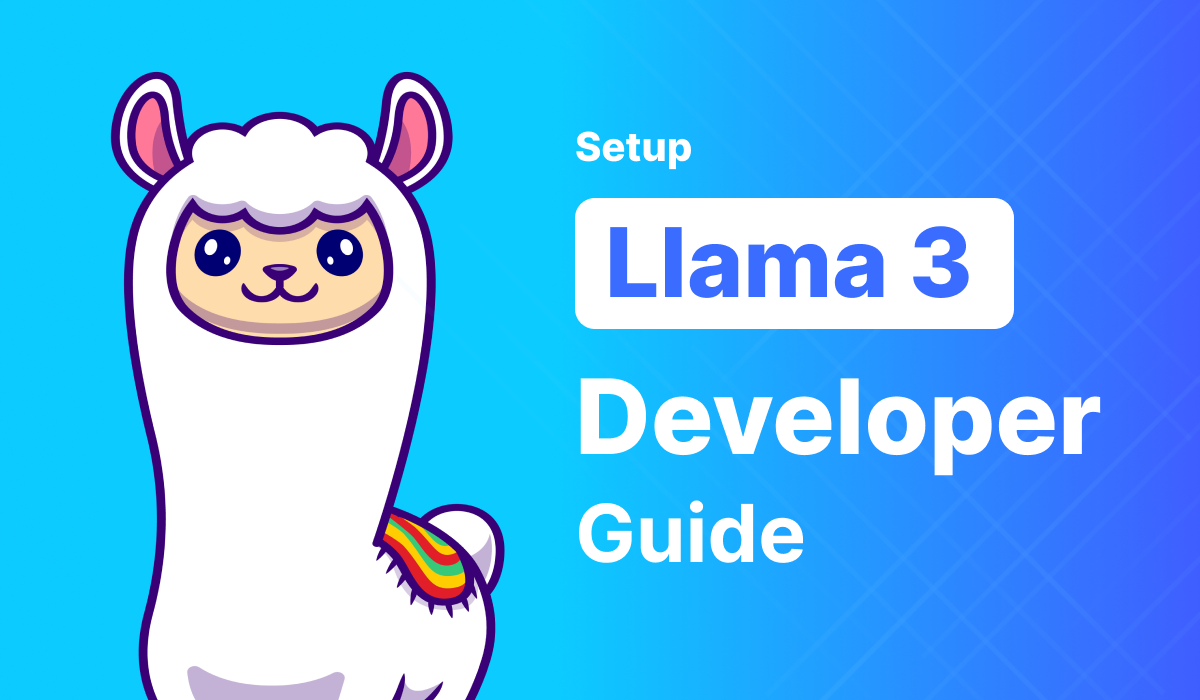How to Install Llama 3 on AWS via Pre-configured AMI Package by Single Click

Introduction of LLAMA 3
Llama 3, the latest iteration of Meta's large language model, represents a significant leap forward in AI technology. This generative model is designed to handle a wide range of tasks, from natural language processing to complex problem-solving. With its enhanced capabilities, Llama 3 offers improved accuracy, faster processing times, and a more nuanced understanding of context compared to its predecessors. These advancements make Llama 3 a powerful tool for developers, researchers, and businesses looking to leverage AI for innovative solutions.
Llama 3 stands out due to its advanced architecture and extensive training on diverse datasets. This combination enables it to generate human-like text, understand complex queries, and provide more accurate and relevant responses. Whether you're developing chatbots, automating customer service, or engaging in sophisticated data analysis, Llama 3 provides the flexibility and power needed to achieve outstanding results.
Advantages of Pre-configured AWS Setup
Deploying Llama 3 on AWS using a pre-configured setup offers numerous benefits, particularly in terms of ease and efficiency. One of the most significant advantages is the reduction in setup time. Instead of manually configuring servers, installing necessary software, and troubleshooting potential issues, users can deploy Llama 3 with a single click. This streamlined process saves valuable time and reduces the risk of errors.
A pre-configured AWS setup also ensures optimal performance. These setups are designed with best practices in mind, ensuring that the hardware and software configurations are perfectly matched to the needs of Llama 3. This results in faster processing speeds, better resource utilization, and an overall smoother experience.
Moreover, using AWS for deploying Llama 3 provides scalability. As your needs grow, you can easily scale your resources up or down without significant downtime. This flexibility is crucial for businesses that need to adapt quickly to changing demands.
In addition to these practical benefits, a pre-configured AWS setup enhances security. AWS offers robust security features, including encrypted data storage, secure access controls, and compliance with various regulatory standards. This ensures that your data and applications are protected against unauthorized access and other security threats.
Lastly, the cost-effectiveness of a pre-configured AWS setup cannot be overstated. By leveraging AWS's pay-as-you-go model, you only pay for the resources you use. This makes it an economical choice for both small businesses and large enterprises looking to optimize their budgets while still accessing top-tier AI capabilities.
The combination of Llama 3's advanced capabilities and the convenience of a pre-configured AWS setup provides an unmatched solution for those looking to harness the power of AI quickly and efficiently. Whether you are a developer, researcher, or business leader, this setup can help you achieve your goals with minimal hassle and maximum effectiveness.
Quick Video Guide
Prerequisites
Hardware Requirements
Running Llama 3 efficiently requires specific hardware configurations to ensure optimal performance. Here are the minimum specifications you should consider:
- CPU: A modern multi-core processor with high clock speeds. Intel Xeon or AMD EPYC processors are recommended.
- RAM: At least 16 GB of RAM for basic operations, but 32 GB or more is preferable for handling more extensive tasks and ensuring smooth performance.
- Storage: SSD storage is crucial for faster read/write operations. At least 500 GB of SSD storage is recommended.
- GPU: For tasks involving heavy computations such as deep learning and AI model training, a high-performance GPU like NVIDIA Tesla, V100, or A100 is essential. These GPUs offer the necessary computational power and memory bandwidth to handle Llama 3’s demands efficiently.
Basic AWS Knowledge and Account Setup
To deploy Llama 3 on AWS, you need to have a foundational understanding of AWS services and an active AWS account. Here’s a brief overview:
- AWS Account: Ensure you have an AWS account. If not, you can create one at the AWS website.
- IAM Roles: Understand the basics of AWS Identity and Access Management (IAM) to set up roles and policies for secure access control.
- VPC and Networking: Familiarize yourself with Amazon Virtual Private Cloud (VPC) to manage network settings and ensure your instances are securely accessible.
- EC2 Instances: Basic knowledge of Amazon EC2 (Elastic Compute Cloud) is crucial, as you will use this service to launch and manage your instances.
- AWS CLI: The AWS Command Line Interface (CLI) can simplify the process of managing your AWS services. Installing and configuring the AWS CLI can be very helpful.
Suitable Server Types
Choosing the right instance type on AWS is critical for achieving the best performance with Llama 3. Here are some recommended instance types:
- Compute-Optimized Instances (C5, C6i): These instances are ideal for compute-intensive tasks. They offer a high ratio of CPU to memory, making them suitable for running Llama 3.
- Memory-Optimized Instances (R5, R6i): These instances are designed for memory-intensive applications. If your workload requires large amounts of memory, these instances provide the necessary resources.
- GPU Instances (P3, P4): For tasks that require significant computational power, such as deep learning and AI model training, GPU instances like P3 and P4 are recommended. These instances are equipped with powerful NVIDIA GPUs that accelerate computation and improve performance.
By ensuring you have the appropriate hardware, AWS knowledge, and choosing the right server type, you can set up and run Llama 3 efficiently, leveraging its advanced capabilities for your AI projects.
Why Use a Pre-configured AWS Setup for Llama 3?
Speed and Efficiency
- Quick Deployment: The pre-configured setup allows for rapid deployment of Llama 3, making it accessible within minutes. This is particularly beneficial for projects with tight deadlines or when quick scaling is required.
- Reduced Setup Complexity: Eliminates the need for manual installation of dependencies and configurations, which can be error-prone and time-consuming.
- Pre-tested Configurations: The configurations provided in the pre-configured setup have been thoroughly tested, ensuring stability and reliability right from the start.
Optimized Performance
- Tailored Configurations: The settings are optimized specifically for Llama 3, ensuring that the instance runs at peak performance.
- Resource Management: Efficient use of computational resources, reducing overhead and maximizing throughput.
- Automatic Scaling: Easily scale your resources up or down based on workload demands, ensuring optimal performance without unnecessary expenditure.
Cost-Effectiveness
- Reduced Initial Costs: Avoid the high upfront costs associated with traditional server setups. AWS’s pricing model allows you to pay only for what you use.
- Lower Maintenance Costs: Reduced need for ongoing maintenance and technical support, as the setup is managed by AWS.
- Flexibility: AWS offers various pricing options, including spot instances and reserved instances, which can further reduce costs depending on your usage patterns.
Step-by-Step Llama 3 Installation Guide
Full Developer Guide

Welcome to the Llama 3 Developer Guide for AWS integration! Experience the cutting-edge performance of Llama 3, boasting enhanced scalability and refined post-training processes. Elevate your AI projects with its advanced capabilities in language understanding, translation, dialogue generation, reasoning, code generation, and more. Let's dive in and unlock the full potential of Llama 3 within your AWS environment.
Llama 3 Single-click AWS Deployment
Explanation: How Single-click Deployment Works
The single-click deployment method leverages AWS CloudFormation templates to automate the setup of your Llama 3 environment. This method ensures all necessary resources are created and configured correctly without manual intervention, significantly reducing deployment time and complexity.
Steps to Follow: Detailed Steps for a Smooth Setup
Video
- Find and Select 'Llama 3' AMI:
- Log in to your AWS Management Console.
- Search for and select the 'Llama 3' AMI from the AWS Marketplace.
2. Initial Setup & Configuration:
- Click "Continue to Subscribe."
- Accept the terms and conditions by clicking "Accept Terms."
- Wait for the processing to complete, then click "Continue to Configuration."
- Select "CloudFormation Template for Llama 3 deployment" as the fulfillment option and choose your preferred region.
- Click "Continue to Launch."
- In the "Launch this software" page, select "Launch CloudFormation" from the "Choose Action" dropdown and click "Launch."
3. Create CloudFormation Stack:
- Ensure "Template is ready" is selected under "Prepare template" and click "Next."
- Provide a unique stack name, admin email, and other required details.
- Configure instance type, key name, SSH location, and CIDR blocks.
- Review the settings, acknowledge the IAM resources creation, and submit the stack creation.
4. Update DNS:
- Copy the public IP from the "Outputs" tab of your CloudFormation stack.
- Update your DNS settings in AWS Route 53 with the copied public IP to map to your domain.
5. Access Llama 3:
- Use the "DashboardUrl" or "DashboardUrlIp" provided in the "Outputs" tab to access Llama 3.
- If you encounter a "502 Bad Gateway" error, wait for a few minutes and try again.
6. Generate SSL Manually (if necessary):
- If automatic SSL setup fails, login to the server via SSH and run the command to generate SSL certificates.
Llama 3 Manual Installation (For Reference)
Server Setup and Requirements
- Instance Setup:
- Launch an EC2 instance with the required specifications (e.g., g5g.16xlarge).
- Install necessary dependencies such as Python, CUDA, and other libraries.
2. Llama 3 Installation:
- Download and install Llama 3 from the official repository.
- Configure environment variables and dependencies.
3. Configuration and Performance Optimization:
- Adjust configuration files to optimize resource usage.
- Implement performance tuning based on your specific requirements.
Post-installation Steps
Verifying Installation
- Check Services: Ensure all Llama 3 services are running correctly.
- Run Test Commands: Execute basic test commands to confirm functionality.
Integration: Connect with Tools: Integrate Llama 3 with other tools and platforms, such as data storage solutions, APIs, and front-end interfaces.
Troubleshooting Common LLAMA 3 Issues
Potential Issues and Solutions
- Instance Capacity Errors: If facing capacity issues, try different regions or increase your instance quota.
- DNS Issues: Ensure DNS settings are correctly updated and propagated.
- Access Errors: Verify security group settings and SSH access permissions.
Additional Help
- Refer for More: LLAMA 3 Guide
- Resources: Consult AWS documentation and Llama 3's official guides.
- Support: Reach out to Meetrix Support for further assistance: hello@meetrix.io
By following this comprehensive guide, you can effectively deploy Llama 3 on AWS, harnessing its advanced capabilities for your AI projects. Whether you choose the single-click deployment or a manual setup, this guide ensures a smooth and efficient installation process.
ChatGPT vs Llama 3 Comparison
Feature Comparison
1. Model Architecture:
- ChatGPT: Developed by OpenAI, based on the GPT-3 architecture.
- Llama 3: Developed by Meta, with an updated architecture from Llama 2, focusing on enhanced language understanding and generation capabilities.
2. Training Data:
- ChatGPT: Trained on a broad range of internet text to develop its language capabilities.
- Llama 3: Trained on a diverse dataset with significant multilingual support, including over 30 languages.
3. Use Cases:
- ChatGPT: Widely used for conversational AI, customer support, content creation, and more.
- Llama 3: Versatile in applications such as language translation, dialogue generation, code generation, and complex reasoning tasks.
4. Performance:
- ChatGPT: Known for its coherent and contextually relevant responses.
- Llama 3: Emphasizes advanced contextual understanding and faster processing times.
5. Deployment and Accessibility:
- ChatGPT: Available through OpenAI's API, integrated into various applications.
- Llama 3: Available via pre-configured AWS setups, accessible on multiple cloud platforms.
6. Customization:
- ChatGPT: Offers fine-tuning capabilities for specific applications.
- Llama 3: Also provides customization options, with optimized performance settings in pre-configured environments.
7. Security and Compliance:
- ChatGPT: Includes measures for data privacy and compliance with regulations.
- Llama 3: Focuses on secure deployment options with enhanced security features integrated into AWS setups.
Both ChatGPT and Llama 3 are powerful AI models with unique strengths. ChatGPT excels in conversational AI and is widely integrated into various platforms, while Llama 3 offers advanced language processing capabilities and optimized deployment on AWS. The choice between them depends on specific use cases, performance needs, and deployment preferences.
Updated: Comparison of Llama 3v s Llama 2 vs GPT-Omni vs Google Gemini
When considering the latest AI models, it's essential to compare Llama 3 with its predecessor, Llama 2, and competitors GPT-Omni and Google Gemini. Llama 3 stands out with optimized performance, faster processing, and enhanced security features. It supports multiple languages and offers high customizability, making it ideal for advanced NLP tasks and real-time processing. Llama 2, while efficient, does not match the performance enhancements of Llama 3. GPT-Omni, known for its high accuracy and scalability, offers advanced conversational AI capabilities. Google Gemini brings robust performance and integration with Google's ecosystem, making it a strong option for diverse AI applications.
| Feature | Llama 3 | Llama 2 | GPT-Omni | Google Gemini |
|---|---|---|---|---|
| Version | Latest | Previous | Latest | Latest |
| Performance | Optimized for faster processing and accuracy | Optimized, but less efficient than Llama 3 | Advanced performance with high accuracy | High performance with robust integration |
| Deployment | Single-click AWS deployment | Single-click AWS deployment | Available via multiple cloud providers | Available via Google Cloud Platform |
| Scalability | High scalability | High scalability | High scalability | High scalability |
| Language Support | Multiple languages | Multiple languages | Multiple languages | Multiple languages |
| Customizability | Highly customizable | Customizable | Highly customizable | Highly customizable |
| Use Cases | Advanced NLP tasks, real-time processing | General NLP tasks, real-time processing | Advanced NLP tasks, conversational AI | Diverse AI applications, including NLP |
| Security | Enhanced security features | Standard security features | Enhanced security features | Advanced security features |
| Official Guide | Llama 3 Guide | Llama 2 Guide | GPT-Omni Guide | Google Gemini Guide |
| Support | Meetrix Support (hello@meetrix.io) | Meetrix Support (hello@meetrix.io) | GPT-Omni Support (support@gpt-omni.com) | Google Support (support@google.com) |
| Resource Links | AWS Documentation, Llama 3 Official Guide | AWS Documentation | AWS Documentation, GPT-Omni Official Guide | Google Cloud Documentation, Google Gemini Official Guide |
For additional help, consult AWS documentation and Llama 3's official guides, or reach out to Meetrix Support at hello@meetrix.io.
Advanced Configuration
Environment Variables
Configure environment variables to customize Llama 3 settings. This allows for dynamic configuration adjustments without changing the codebase.
Network Optimization
- Optimize network settings to enhance data throughput and reduce latency.
- Ensure proper configuration of VPC, subnets, and security groups for efficient network traffic management.
Custom Scripts
Utilize startup scripts to automate post-deployment tasks such as software installation, configuration changes, and service setups.
Security Enhancements
Data Encryption
- At Rest: Use AWS services like S3 or EBS with encryption to secure stored data.
- In Transit: Implement SSL/TLS to protect data during transfer between clients and servers.
Access Logs
Set up detailed access logs using AWS CloudTrail to monitor and audit all activities within the Llama 3 deployment. This helps in identifying and addressing any unauthorized access.
Integration with CI/CD Pipelines
Continuous Deployment
Automate the deployment process using CI/CD tools such as Jenkins, GitLab CI, or AWS CodePipeline. This ensures consistent and reliable deployments.
Testing Frameworks
Integrate testing frameworks to validate the deployment. This includes unit tests, integration tests, and performance tests to ensure Llama 3 operates as expected.
Cost Management Strategies
Reserved Instances
Leverage reserved instances for long-term cost savings. These instances offer significant discounts compared to on-demand pricing.
Savings Plans
Utilize AWS Savings Plans for flexible cost management, allowing you to save on AWS usage across different services.
Monitoring and Analytics
Advanced Metrics
Set up detailed performance metrics using AWS CloudWatch to monitor Llama 3’s performance. Track CPU usage, memory utilization, and network traffic.
Alerting Systems
Configure alerting systems for critical performance thresholds. This helps in proactive management of resources and quick resolution of potential issues.
Data Management
Data Storage Solutions
Compare different AWS storage options for storing model data:
- EFS: Suitable for shared file storage.
- EBS: Ideal for block storage.
- S3: Best for object storage with high scalability.
Data Lifecycle Policies
Implement data lifecycle policies to manage data retention and deletion, ensuring efficient use of storage resources and cost savings.
Use Cases and Applications
Specific Industry Applications
Explore how different industries can benefit from Llama 3:
- Healthcare: Enhancing patient diagnosis and treatment plans with advanced data analysis.
- Finance: Improving risk management and fraud detection through predictive analytics.
- Retail: Enhancing customer experience with personalized recommendations.

